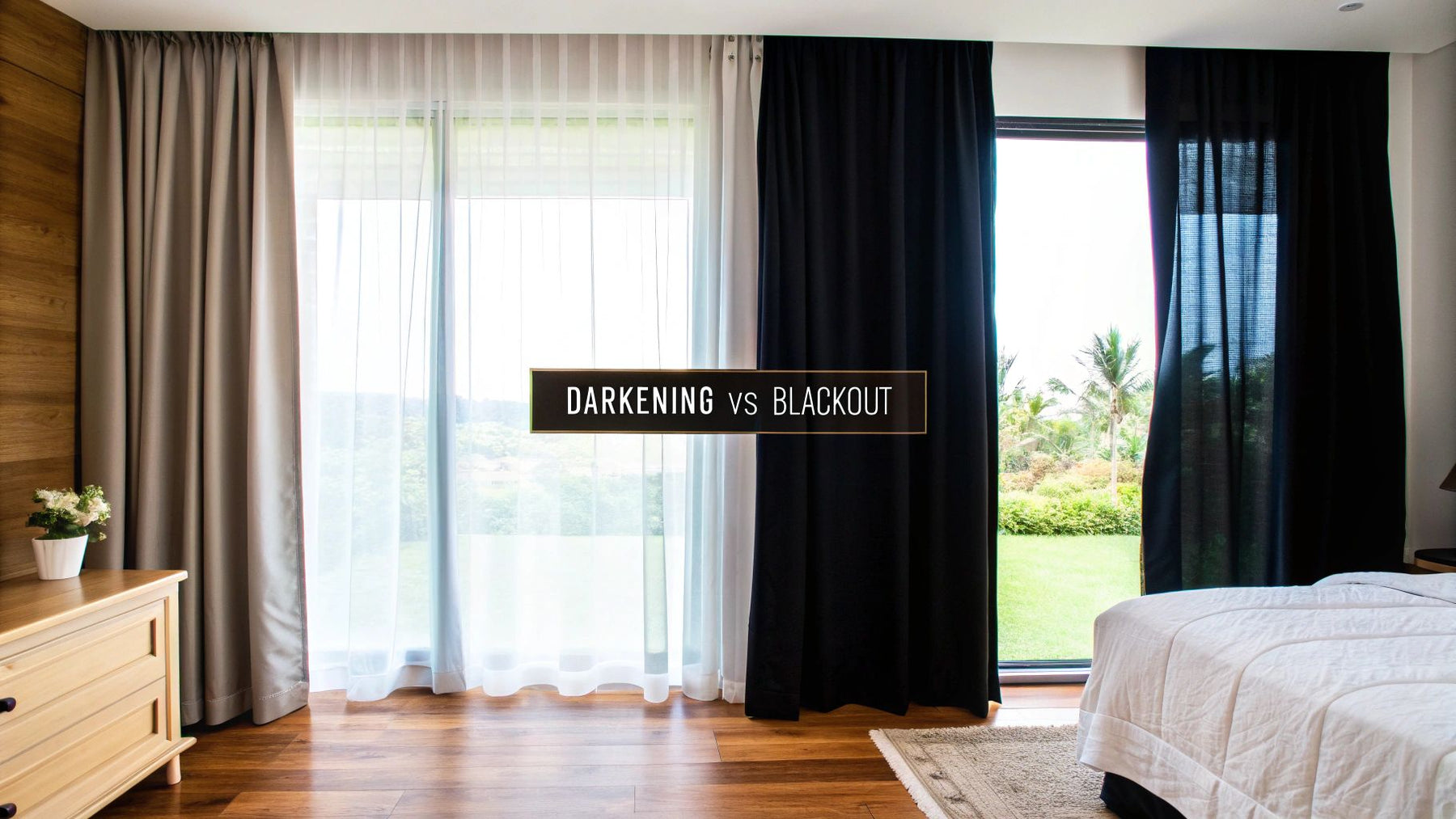
Room Darkening vs Blackout Curtains: Which Is Right for You?
So, you're trying to choose between room darkening vs blackout curtains. The main difference is simple: blackout curtains are designed to block nearly 100% of light for total darkness, while room darkening curtains significantly dim it, leaving a soft glow. Your choice hinges on whether you need a pitch-black, cave-like space or just want to cut the glare.
This guide will break down the key differences in light blockage, materials, energy efficiency, and cost, helping you decide which window treatment is the perfect fit for your home.
Table of Contents
- What's the Real Difference?
- How Much Light Do They Actually Block?
- Comparing Material and Construction
- Energy Efficiency and Insulation Benefits
- Which Curtain Is Right for Your Space?
- A Look at Style and Budget
- Frequently Asked Questions
What's the Real Difference?
When you're looking at window treatments, understanding what each type is designed to do is the first step. Both are meant to reduce sunlight, but they achieve this with different levels of intensity, materials, and construction methods. This is why matching the right curtain to the right space is so important.
A blackout curtain's primary job is to create a pitch-black environment. This is why they’re a go-to for bedrooms, nurseries, and home theaters. They accomplish this with a multi-layered design, often featuring a dense foam core or a tightly woven fabric with a special lining that completely stops light in its tracks.
Room darkening curtains, on the other hand, are built to filter and reduce light, not eliminate it entirely. They're usually made from a single, thick layer of a tightly woven fabric like velvet or a heavy polyester. This design is perfect for dimming a room—like cutting the glare on a TV in the living room—but you’ll still see a gentle glow of light.
This quick comparison chart lays out the key differences in light blockage, insulation, and cost.
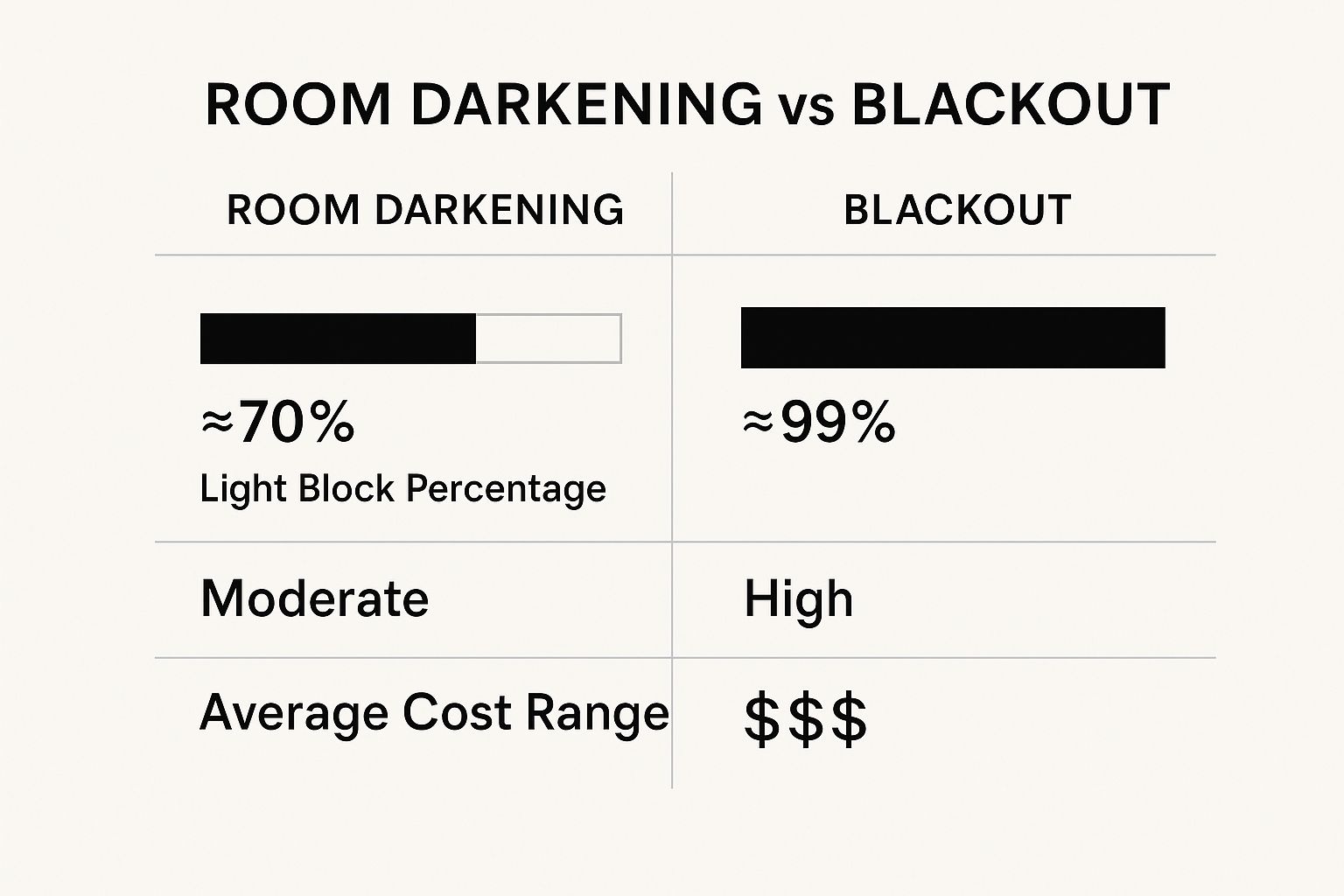
As you can see, while both have their benefits, blackout curtains are the clear winner for superior light blocking and insulation, which is reflected in their higher price.
Quick Comparison: Room Darkening vs Blackout Curtains
To give you a quick snapshot of the fundamental differences, here's a simple table. It's a high-level summary that helps you see the key distinctions at a glance.
| Feature | Room Darkening Curtains | Blackout Curtains |
|---|---|---|
| Light Blockage | Blocks 70-90% of light, creating a dim ambiance. | Blocks 95-100% of light for total darkness. |
| Primary Material | Single layer of thick, tightly woven fabric. | Multi-layered construction with a foam or fabric core. |
| Best For | Living rooms, offices, and dining areas where some light is desired. | Bedrooms, nurseries, and home theaters needing absolute darkness. |
| Energy Efficiency | Offers moderate insulation against heat and cold. | Provides high-level thermal insulation, leading to energy savings. |
Hopefully, this makes the choice a little clearer. One offers a muted glow, while the other delivers total darkness—it's all about what your room needs.
How Much Light Do They Actually Block?
When we talk about the difference between room darkening and blackout curtains, it’s about more than just percentages. It really comes down to the kind of atmosphere you're trying to create in your home. Blackout curtains are engineered for absolute darkness, while room darkening curtains aim for a soft, deep twilight feel.
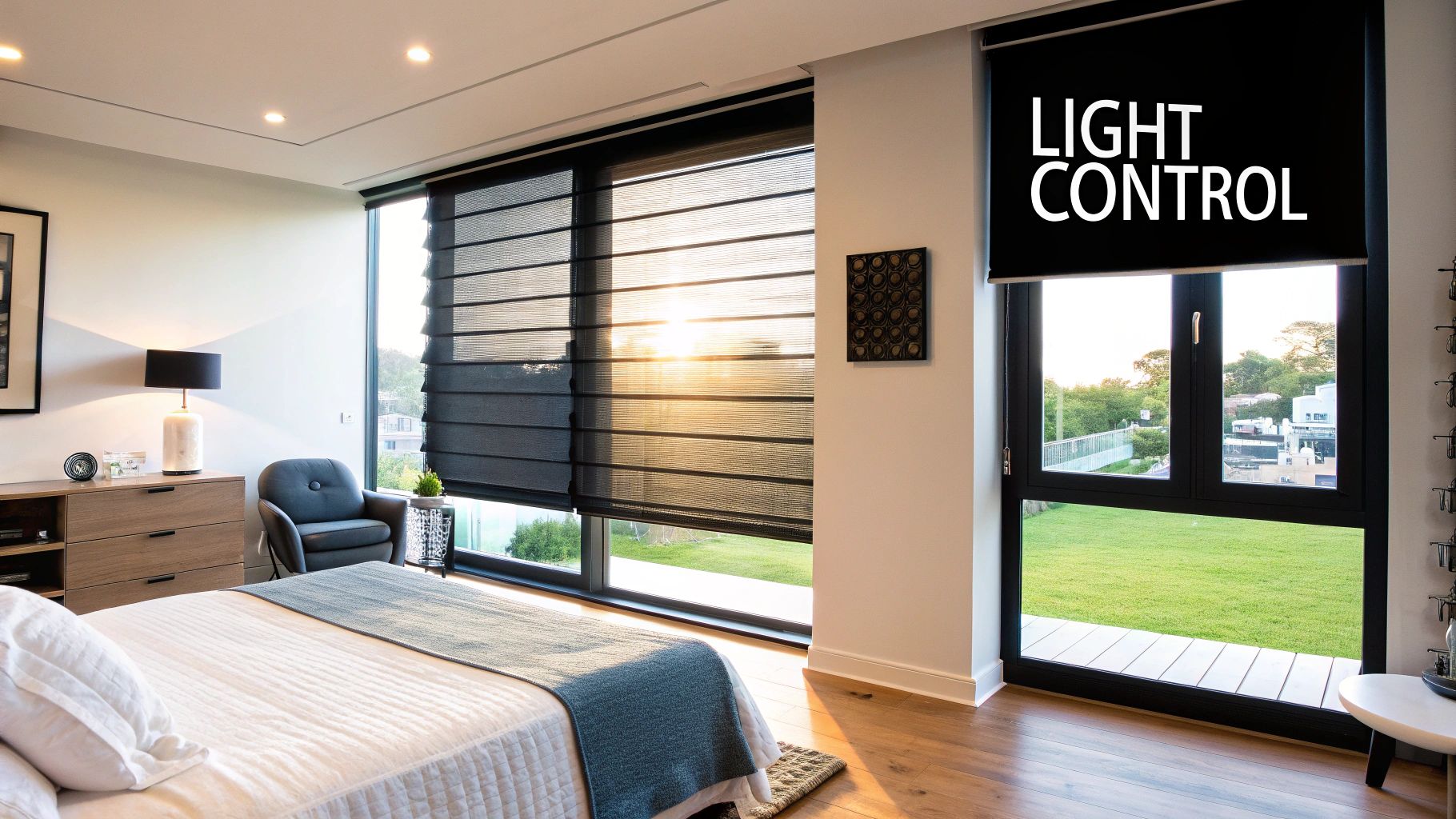
The secret is all in how they’re made. A true blackout curtain is built to be an impenetrable light barrier. It’s made with several layers, often with a dense foam core or a special light-blocking liner bonded right to the fabric. This construction is engineered to stop light in its tracks.
Room darkening curtains, on the other hand, typically use a single, very thick layer of tightly woven fabric. Think heavy polyester or velvet. This weave doesn't completely block light but diffuses and filters it, making the room significantly dimmer without turning it into a cave.
The Blackout Experience: Total Darkness
Think about your bedroom on a bright Saturday afternoon. With a good set of blackout curtains drawn, you can transform that sunny room into a pitch-black space. It’s perfect for grabbing a nap or for a night-shift worker who needs to sleep during the day.
This is why they’re the go-to choice for certain situations. A 2022 study showed that 88% of people who bought blackout curtains found them highly effective. When the best ones were tested against strong light sources, they blocked nearly all of it.
Key Insight: Blackout curtains don't just dim the room; they're designed to completely remove outside light from the equation. This makes them the ultimate choice for light-sensitive sleepers, nurseries, and home theaters.
To get that true blackout effect, every detail counts. The color of the liner and the weave of the fabric are huge factors. Even a small gap around the edges can create a "halo" of light, which is why picking the right size and installation method is so important. For more help with this, feel free to check out our ultimate guide to finding the best blackout curtains.
The Room Darkening Effect: A Gentle Dimmer Switch
Now, imagine trying to work in your home office when the midday sun is blasting your screen. This is where room darkening curtains really shine. They cut that harsh glare and turn it into a soft, ambient glow that’s much easier on the eyes.
It’s like having an overcast day on demand. The room stays comfortable and usable, so you don’t have to flick on every artificial light just to see.
This balance makes them incredibly versatile for everyday living spaces:
- Living Rooms: They stop glare on the TV and protect your furniture from fading without making the room feel closed off.
- Home Offices: They create a great work environment by cutting screen glare while still letting in some natural light.
- Dining Areas: They can help you set a more intimate, moody atmosphere for dinner.
At the end of the day, room darkening curtains offer a wonderful compromise. You get great light reduction and privacy, but you can still sense the time of day and enjoy a hint of natural light.
Comparing Material and Construction
The real magic behind a curtain's performance comes down to its material and construction. How a curtain is built is what dictates how much light it blocks, how well it insulates, and even the way it hangs. Getting a handle on this difference is the key to picking the right one for your home.
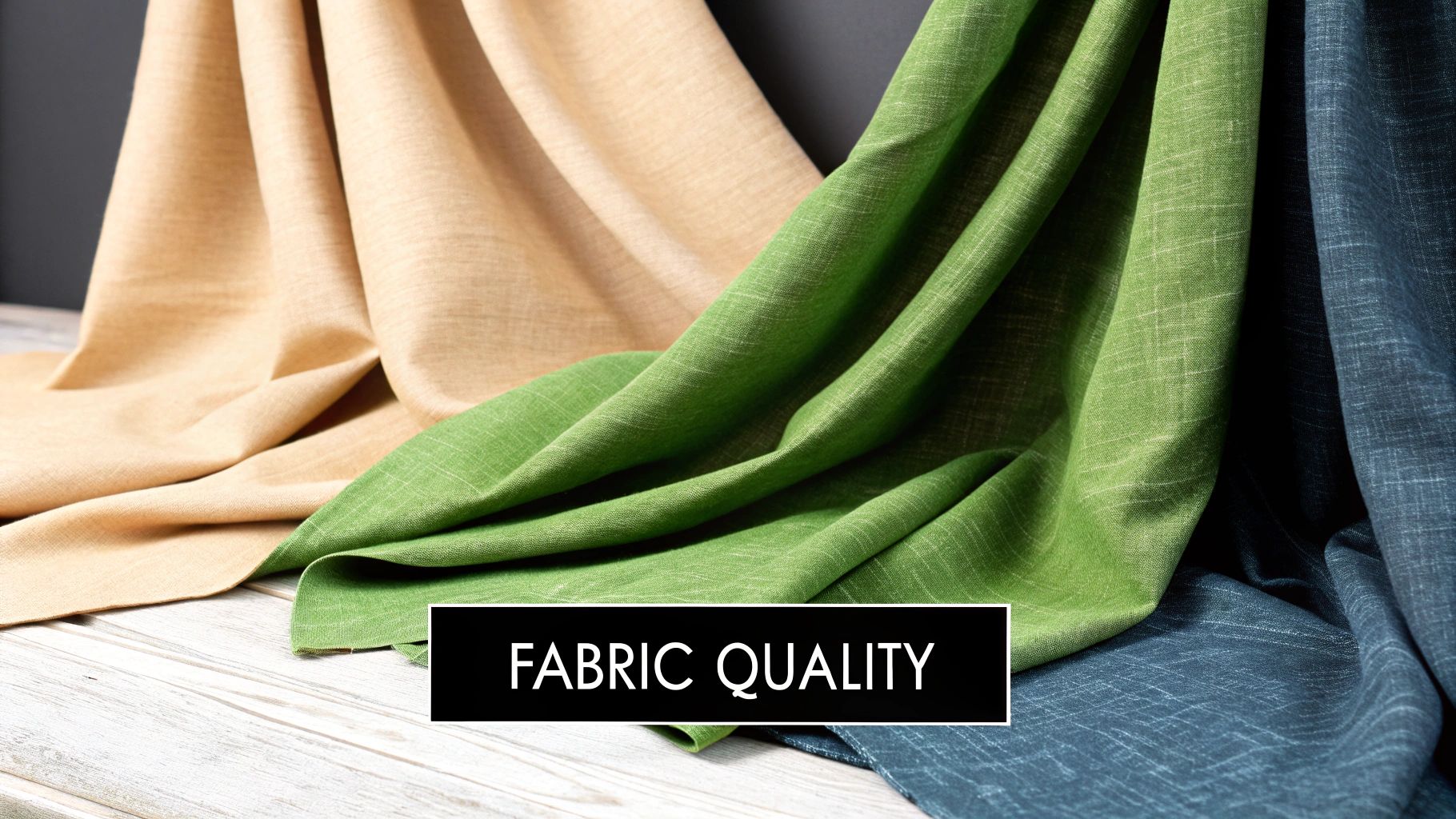
The Heavy-Duty Build of Blackout Curtains
Think of blackout curtains as the heavyweights of window treatments. They’re engineered with a multi-layer system that gives them their unmatched light-blocking power.
- Face Fabric: This is the decorative outer layer you see, available in just about any color or texture you can imagine.
- Inner Core: Here’s the secret weapon. It’s usually a layer of black foam or an incredibly dense fabric lining that absorbs light before it can get through.
- Thermal Backing: The final layer often has a special thermal coating to boost insulation, reflecting heat out in the summer and trapping it in during the winter.
This trio of layers works together to create a heavy, opaque barrier that is almost impossible for light to penetrate.
The Simpler, Yet Effective Weave of Room Darkening Curtains
Room darkening curtains, on the other hand, rely on a much simpler (but still effective) single-layer design. Their performance comes from using a single, incredibly thick panel of tightly woven fabric. You'll often see materials like heavy polyester, velvet, or microsuede used here because their dense weave naturally filters out a huge amount of light.
To really understand the spectrum of light control, it helps to look at different materials. For instance, exploring the characteristics of linen curtains shows you how different fabric weights and weaves stack up against specialized light-blocking options. While beautiful, a standard linen curtain just won't offer the same dimming effect as a purpose-built room darkening panel.
Expert Tip: Don't forget that the construction goes beyond the fabric itself. Pay close attention to the curtain's header style. Grommet tops might look stylish, but they can let small slivers of light peek through around the rod. If you want maximum darkness, a wrap-around rod or a rod pocket style that sits flush against the wall is a much better bet.
At the end of the day, the complex, layered build of blackout curtains provides an uncompromising barrier to light. The dense, single-layer fabric of room darkening curtains offers a substantial solution, but one that is less total.
Energy Efficiency and Insulation Benefits
When you're deciding between room darkening vs blackout curtains, you're looking at more than just light control. You're actually making a choice that can impact your home's comfort and your energy bills. The same design that blocks light also creates an impressive thermal barrier, helping you manage indoor temperatures all year long. This turns your curtain choice from a simple aesthetic decision into a smart, practical investment.
Because blackout curtains are built with dense, multiple layers, they are far superior insulators. Think of them as a shield for your windows, which are often the biggest culprits for energy loss in a house. During those scorching summer months, they do a fantastic job of blocking solar heat, keeping your rooms cooler and giving your air conditioner a much-needed break.
When winter rolls around, they work in reverse, adding an extra layer of insulation that traps indoor heat and stops it from escaping through the cold glass. This kind of temperature regulation can really add up, leading to noticeable savings on your energy bills over time.
The Thermal Performance Breakdown
While blackout curtains are the clear champs in the thermal department, room darkening curtains are no slouches either. They offer a solid middle-ground option, providing a significant boost in insulation compared to standard, unlined drapes.
- Blackout Curtains: Thanks to their heavy, often foam-backed construction, these curtains can slash heat loss through a window by up to 25% in the winter. In the summer, they can block up to 33% of solar heat gain, making them a powerful tool for keeping your home's climate consistent.
- Room Darkening Curtains: These are typically made from a single, thick layer of tightly woven fabric, but they still provide a valuable buffer. They're effective at reducing drafts and moderating temperature swings, just not quite to the same degree as their multi-layered cousins.
The demand for window treatments that do double duty is growing, and it's easy to see why. The global blackout curtains market was valued at around $3.82 billion in 2023, largely driven by people wanting both total light blockage and real energy savings.
A Smart Investment in Home Comfort
Ultimately, choosing between the two really comes down to your local climate and how serious you are about saving energy. If you live somewhere with extreme weather—think blistering summers or frigid winters—the superior insulation from blackout curtains offers a fantastic return on your investment.
For those in more temperate climates, however, room darkening curtains are a great, cost-effective way to make your home more comfortable without plunging it into complete darkness. They strike a nice balance, giving you noticeable thermal benefits while still letting the room feel soft and ambient.
To get a better handle on how different materials play a role in thermal efficiency, take a look at our ultimate guide to insulated and thermal curtains. It can help you zero in on the exact style that fits your home's needs perfectly.
Which Curtain Is Right for Your Space?
Choosing between room darkening and blackout curtains isn't about which one is "better." It's about finding the perfect match for how you use a room. A curtain that works wonders in one space might feel completely out of place in another.
The heart of the matter is finding that sweet spot between your need for total darkness and your desire for some natural light. By thinking through what each room is for, you can confidently pick the right window treatment every time.
For Spaces Demanding Absolute Darkness
For certain rooms, anything less than complete darkness just won't do. These are the spaces where controlling light isn't just a preference—it's a requirement for the room to serve its purpose.
Blackout curtains are the definitive choice for:
- Bedrooms and Nurseries: Deep, restorative sleep requires an environment free from disruptive light. Blackout curtains are your best defense against early morning sun, streetlights, and passing cars, creating a true sanctuary for uninterrupted rest.
- Home Theaters: To get that truly immersive movie-watching experience, you have to control every last bit of ambient light. For any dedicated home theater room design, blackout curtains are non-negotiable. They stop glare and prevent washed-out colors on the screen, giving you that authentic cinema feel.
Key Takeaway: If a room's primary job is promoting sleep or high-quality media viewing, there’s simply no substitute for the uncompromising light-blocking power of a true blackout curtain.
For Areas That Thrive on Muted Light
Many rooms in a home are multi-functional spaces where you want to cut down on harsh sunlight without plunging the room into darkness. In these areas, the goal is comfort and ambiance, which makes room darkening curtains the clear winner.
Room darkening curtains typically filter out about 70-90% of light. That's more than enough to slash glare and heat while still letting a soft, natural glow fill the space. This makes them ideal for the common areas where you live, work, and relax throughout the day.
Room darkening curtains are best suited for:
- Living and Family Rooms: They do a fantastic job of reducing glare on TV screens and protecting your furniture, floors, and artwork from fading, all while keeping the space feeling bright and welcoming.
- Home Offices: By diffusing that harsh midday sun, they create a much more comfortable working environment that reduces eye strain and annoying screen reflections, helping you stay productive.
- Dining Areas: These curtains can help set a more intimate mood for meals by softening intense daylight. You can create a pleasant ambiance without having to flick on the artificial lights.
By matching the curtain to the room's function, you create a home that's not just more beautiful, but more comfortable and practical, too. For a deeper dive into picking the perfect pair, check out our guide on how to choose the best room darkening curtains.
A Look at Style and Budget
Beyond pure function, the final decision often comes down to two practical things: how the curtains will look in your space and how they fit your budget. When weighing room darkening vs blackout curtains, understanding the differences in price and design is the last step to making a choice you’ll love.
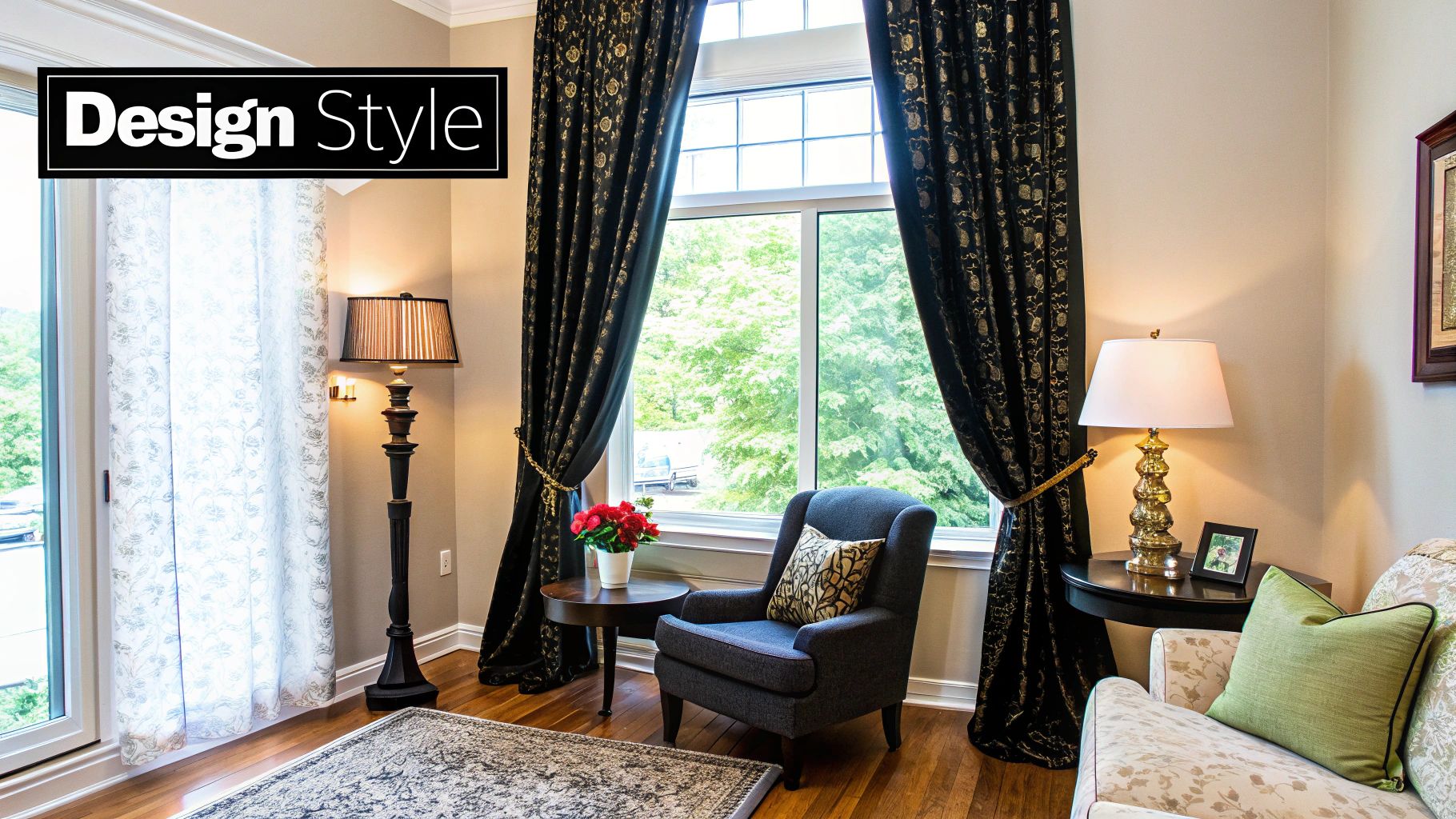
The biggest factor driving cost is how they’re made. Blackout curtains, with their complex, multi-layered construction and specialized thermal linings, are simply a more significant investment. It takes more material and a more involved engineering process to achieve nearly 100% light blockage, and that’s naturally reflected in the price.
Room darkening curtains, on the other hand, are generally much friendlier on the wallet. Their simpler, single-layer build means less material and a more straightforward manufacturing process, making them a great option if you want effective light control without the premium price tag.
Finding a Style That Fits Your Home
Aesthetics matter just as much as function. Thankfully, the days of stiff, purely utilitarian blackout curtains in a handful of drab colors are long gone. Today's market is full of surprisingly stylish options that blend high-performance features with sophisticated design.
Expert Insight: While modern blackout curtains have come a long way, room darkening options still hold the edge in decorative flexibility. Because they're a single layer of fabric, they lend themselves better to more delicate textures, intricate patterns, and a wider spectrum of on-trend colors.
Keep these stylistic differences in mind as you choose:
- Room Darkening Curtains: You'll typically find a broader array of fabrics here, from lighter weaves to more fashionable prints. They're perfect when the decorative look is a top priority, like in a living room or dining area.
- Blackout Curtains: While they are getting more stylish, their main job is still performance. They truly excel at creating a cohesive, elegant look in bedrooms or media rooms, often in rich solid colors or simple textures that contribute to a calm, serene atmosphere.
Ultimately, your decision is a balancing act. If you're working with a tighter budget or have your heart set on a very specific, trend-forward look, room darkening curtains are an excellent choice. But if your main goal is maximum performance—and you see the higher cost as an investment in better sleep and energy savings—then blackout curtains deliver value that’s hard to beat.
Frequently Asked Questions
To help you feel completely confident in your choice, we’ve gathered some of the most common questions we get about room darkening and blackout curtains. Let’s clear up those final details on privacy, noise, and installation.
How Much Privacy Do Room Darkening and Blackout Curtains Offer?
The short answer is: both offer excellent privacy. Room darkening curtains are made with a thick, opaque weave that completely obscures shapes and silhouettes from the outside, day or night. Blackout curtains take that privacy to the next level with their multi-layered, impenetrable construction.
Can Room Darkening or Blackout Curtains Reduce Noise?
Yes, especially blackout curtains. While neither option will completely soundproof a room, the dense, multi-layered fabric of blackout curtains offers significant sound-dampening qualities. They do a great job muffling ambient noises like street traffic or neighborhood chatter. Room darkening curtains also help, providing a noticeable buffer against outside sounds compared to standard drapes.
Are Blackout Curtains Better Than Room Darkening?
It depends on your needs. Blackout curtains are "better" if your goal is absolute darkness and maximum thermal insulation, making them ideal for bedrooms and home theaters. Room darkening curtains are "better" for living areas where you want to reduce glare and gain privacy while still allowing a soft, natural glow.
Do I Need Special Hardware to Hang Heavier Curtains?
Yes, using a sturdy curtain rod is essential. Both curtain types are much heavier than standard drapes. A flimsy rod will sag or break. We always recommend a durable rod made of steel or solid wood, securely mounted brackets (ideally into wall studs), and a center support bracket for wider windows to prevent bowing.
Ready to find that perfect balance of light control, privacy, and style for your home? Explore the curated collection of premium window treatments at Joey'z Shopping.
Browse our full range of room darkening and blackout curtains now!
